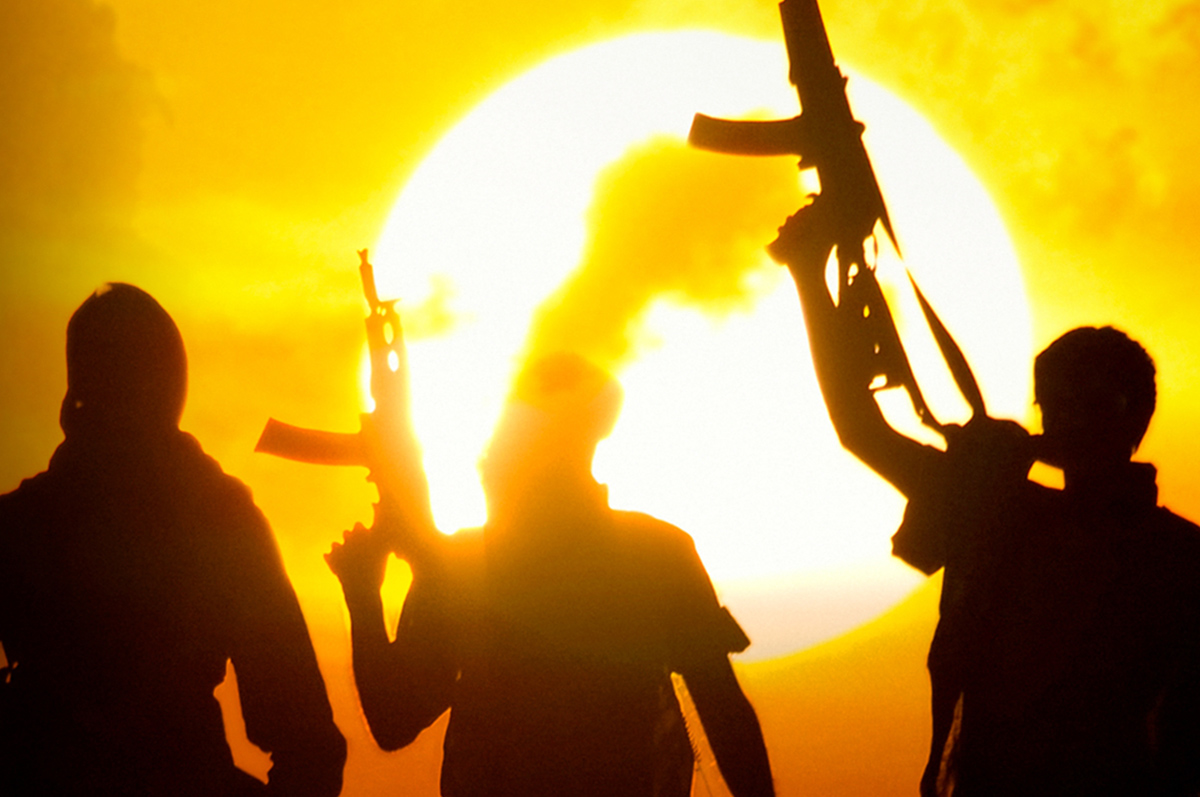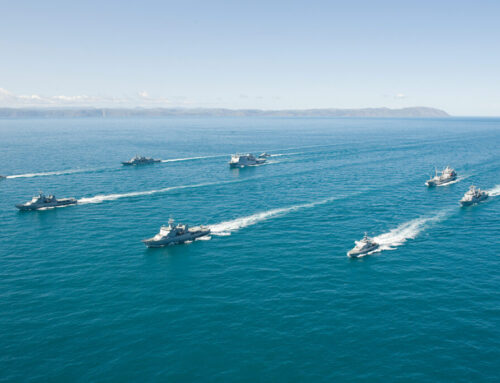PP ANALYSIS The Middle East after the fall of the Islamic State core in the Levant
Autor foto: Domena publiczna

The Middle East after the fall of the Islamic State core in the Levant
August 23, 2017
Author: Tomasz Otłowski




PP ANALYSIS The Middle East after the fall of the Islamic State core in the Levant
Autor foto: Domena publiczna
The Middle East after the fall of the Islamic State core in the Levant
Author: Tomasz Otłowski
Published: August 23, 2017
Pulaski Policy Paper no 17, August 23, 2017
The liberation of the Iraqi city of Mosul at the beginning of July 2017, after more than nine months of bloody battles, as well as the probable occupation of the Syrian city of Ar-Raqqa, the self-proclaimed capital of the caliphate, raises questions about the future of the parastate brought to life by the so-called Islamic State of Iraq and Syria (ISIS) and the geopolitical shape of the Middle East after the fall of ISIS in the Levant. There are also questions about what the liquidation of the caliphate’s headquarters (established on the areas of Iraq and Syria conquered in 2013-2015) will mean, and whether the geopolitical situation in the heart of the Middle East will return to the status quo or whether some other strategic arrangement will appear in the region.
The war against ISIS and its self-proclaimed caliphate has been going on for over three years and there is no doubt that this is largely due to the lack of genuine political will to destroy ISIS. Many actors (especially Saudi Arabia, Turkey, Russia and even Israel), involved in the strategic game in the Middle East region welcomed the existence of the Islamic State in parts of Syria and Iraq, as it served as a cover for their interests in the region, an excuse for direct military involvement, and a tool for exerting strategic pressure on ideological and religious rivals. On the other hand, the United States and European countries have avoided full-scale military action against the caliphate at all costs, especially with the use of land forces.
All this meant that the ‘state’ established by ISIS could last for so long in the Levant, in the meantime creating its cells in other parts of the Middle East, and even in distant regions of the world. The ‘overseas colonies’ of the caliphate, i.e. its provinces (vilayets) located outside the Levant, were meant to disseminate the idea of pan-Islamic jihad in distant parts of the world and make the ‘Islamic state’ an organization of a trans-regional dimension. The branches of the Islamic State appeared in the years 2014-2015 in many parts of the world, where followers of Islam live: from Nigeria to Yemen and Somalia, and from the Caucasus, through the region of AfPak, to the Philippines and Indonesia. In around 2015 it became clear that the caliphate is not only a specific territory in the very heart of the Middle East, but also a wide network of organizations and Islamist groups, recognizing the supremacy of the so-called Islamic State. It was then that ISIS became in fact an international jihadist structure with a global reach, whose organizational and ideological influences extended not only to the majority of the Islamic world (Dar al-Islam), but also to the Western world associated with the ‘world of war’ (Dar al-Gharb/Harb). ISIS started to compete successfully with the previously monopolistic Al-Qaeda. The end of 2015 marked the apogee of the global development of the caliphate, but today, after almost two years, many of the overseas centers of ISIS have ceased to exist (such as the Libyan provinces or vilayets in Algeria and Saudi Arabia). However, several foreign provinces of the caliphate still function, and some of them (e.g. in the Afghan-Pakistani region – Khorasan – and in West Africa) have even increased their role and importance in global ISIS activities. It cannot be ruled out that in the near future they may become the main administrative and political centers of the caliphate, after its headquarters in the Levant have been liquidated.
What is equally important, in the context of its three years of its existence, is that the caliphate ceased to be exclusively a territorial and political entity, becoming also a political and religious concept. While it is relatively easy to remove the physical manifestation of the caliphate from a specific territory (e.g. in Syria, Iraq or Libya), it will be much harder to do the same with its ideological conception, adopted by masses of fanatical supporters ready to give their lives as martyrs. Thus it is almost certain that even the total displacement of ISIS from Iraq and Syria (understood as a total deprivation of its own area in this part of the Middle East) will not be synonymous with the end of the caliphate as such. It is also to be feared that the collapse of the caliphate headquarters in the Middle East will not mean a simple and automatic return to the geopolitical situation in this region from before the summer of 2014. The rise of ISIS and its subsequent three-year long activity, as well as the prolonged bloody civil war in Syria and the increasingly sophisticated ‘game of superpowers’ around it made the return to the old strategic reality in the region no longer possible. The restoration of state borders from three years ago may be problematic in many places. First of all, this applies to Syria, whose territory for years has been torn apart by many opposing factions, and the authorities in Damascus are currently controlling only a negligible part of the former land borders of the state. Some regional players involved in Syria (including Turkey, Jordan and Iran) use this for their own strategic interests in the region. However, much more serious results will be visible in the changes that may occur in the regional balance of power. The collapse of the caliphate headquarters in the Levant, which is already under way, and is increasing with each week, creates a strategic vacuum, encouraging regional and non-regional powers to race for influence and control over the Syrian territories previously owned by ISIS. These lands, located mainly in eastern Syria, are of great strategic importance, concealing the majority of the country’s natural resources (especially natural gas) and allowing control over the entire Syrian interior. The leaders in this race are on the one hand Iran and Russia (the main allies of the Syrian President Bashar al-Assad’s regime), and on the other the United States and Jordan, external jihadist streams, and today the most important sponsors and political patrons of opposition forces against the authorities in Damascus.
For Tehran the areas formerly included in ISIS and located on the border between Syria and Iraq have a special significance. Since 2012, Iran has been investing considerable forces and financial and military resources in helping the government of Bashar al-Assad in Syria. This support, along with Russia’s direct involvement in the Levant from 2015, proved crucial for the survival of the Syrian regime. The strategic goal of the Iranians is to create a ‘Shiite crescent’ in the region – a territorially connected strip of land under Iran’s political and ideological influence, stretching from Iran, through Iraq and Syria, to Lebanon. This goal, which Tehran has been pursuing since the outbreak of the Islamic revolution in 1979, now seems to be very close to being implemented. In this context, Iran is undoubtedly the largest geopolitical beneficiary of developments in the Middle East region over the past few years. Achieving a dominant political position in Iraq by pro-Iranian Shia, survival of the Shia Alawite regime in Syria, and Tehran’s skillful positioning as an important partner of the international community and informal ally of the West in the fight against the Islamic State and its caliphate – all this led to an increase in the geopolitical significance of Iran in the region. The improvement of the general international situation in Tehran was also significantly influenced by the conclusion in July 2015 of a landmark agreement on its nuclear program. This agreement, concluded directly with the world’s largest powers, actually ended the long-term isolation of Iran and strengthened its role as an important regional player. The rise of the Islamic Republic of Iran poses a direct challenge to the Sunni Arab states of the region and a threat to their strategic interests. First of all, this applies to Saudi Arabia and its allies concentrated in the Gulf Cooperation Council (GCC), and to a lesser extent Jordan and Egypt. However, a series of disastrous diplomatic moves undertaken by Riyadh in recent years has led to a situation in which the Kingdom of Saudi Arabia is stuck in a prolonged conflict in Yemen (which is a classic ‘proxy war’ with Iran). The Yemeni war has drained Saudi Arabia’s strength and resources for two years, diverting its strategic attention away from the key theater of geopolitical struggles in the region, namely the Levant, especially Syria. To make matters worse, Riyadh has become so involved in geopolitical games in its immediate international environment (aiming to limit the influence of Tehran) that a deep crisis within the GCC itself has arisen. Its background was the accusations against Qatar over its support for Tehran (and the Shias in the region) and its connections with the Muslim Brotherhood. As a result, both the Saudis and their closest allies from the Gulf have lost many advantages in the game for the future of the Levant, despite appearing to be, for the first years of the Syrian nightmare, the main sponsors of the anti-Assad rebellion. Their role is currently being seized by Jordan, which, with the direct military support of the United States, is actively working on torpedoing Tehran’s strategic plans towards the Levant.
In the north of Syria, also under the pretext of fighting ISIS, Turkey has been trying to fulfill its geopolitical goals, which for a year has been militarily involved on the territory of its southern neighbor. Turkish activities in Syria are changing with varying luck, undermining the myth of military power of Ankara as ‘the second army in NATO.’ Turkey’s goal, however, is essentially to stop the striving for independence of the Kurds from Rojava, who managed to create the seeds of their own statehood during the civil war in Syria, and who received the admiration and sympathy of Western public opinion thanks to the heroic (and most importantly effective) fight against ISIS. Turkey’s Syrian policy is also to keep this country in the game for the future of the entire region and, if possible, to restore the former Ottoman sphere of influence.
Turkey’s concerns are well founded, because one of the most important aspects of the future balance of power in the Middle East region, after the collapse of the caliphate’s headquarters, will be the Kurdish issue. Growing into the role of one of the most important entities fighting ISIS, the Kurds began to demand greater political autonomy in Iraq and Syria. Kurdish postulates and aspirations have understandably met with the opposition of those countries in the region where the Kurds live: Iraq, Syria, Iran, and above all Turkey. Perhaps the end of the campaign against ISIS will mark the beginning of an open and determined war of regional powers (Turkey, Iran, maybe Iraq) with the Kurdish forces in Syria and/or Iraq. The Kurdish guerrilla movement (PJAK) is already active today in Iran, while Turkey for over a year has been engaged in an ongoing war between government forces and the PKK (Kurdistan Workers’ Party) formations. The relations between the government in Baghdad and the Kurdish Regional Government are becoming increasingly tense, mainly due to the upcoming independence referendum in Iraqi Kurdistan.
There is also no doubt that the direct military presence of global powers will be a permanent element of the strategic landscape of the Middle East (and especially of the Levant). Moreover, it is a presence based at least on mutual rivalry, if not outright confrontation, which can be seen with the example of Syria. The situation in this area is extremely dynamic, generating tensions that go far beyond the region of the Middle East.
Recommendations
1. The process of the disintegration of the territorial structures of the caliphate in the Middle East (and especially in the Levant region) is gaining momentum and it is to be expected that within a few months or so their local vilayets will soon be history. The international community should not simply allow this process to follow its own course as it may result in fierce competition for influence, position and new alliances in the region between regional and global powers.
2. The UN has a special role here as an international organization of multilateral diplomacy with a global reach, very much depreciated in recent years. The European Union has been showing restraint for at least three years in terms of interest in the situation in the Levant and involvement in the events taking place there; it may have a lot to do there. It is especially hard to explain that the war in Syria, the criminal activity of the caliphate and the actions of external actors in the Levant, ultimately bring about a whole series of serious threats to Europe’s security, such as mass migration, the expansion of Islamic extremism and terrorism, and the disturbance of the fragile regional power balance.
3. A more active EU policy towards the Levant is also necessary in the context of the processes taking place in the countries of the region. The EU should increase its efforts to assist regional actors in their efforts to implement or consolidate democratic procedures and mechanisms. In the first place this applies especially to Iraq, Jordan and Lebanon, but also to the Kurdistan Region in Iraq.
4. In the latter case, the EU, using its experience and diplomatic instruments, should engage in the mediation between Baghdad and Erbil for a peaceful and lawful referendum to be conducted in September in Iraqi Kurdistan, as well as in activities aimed at implementing its expected results. Europe, and especially France and the United Kingdom still present in the EU structures, owe special support and assistance to the Kurds as compensation for the failure to fulfill obligations from nearly a century ago (Treaty of Sevres, 1920).
5. The international community, and the EU in particular, should guarantee the Syrian Kurds the right to maintain the autonomy which they created during the present war (e.g. following the system in force in Iraq). In particular, the international community should provide the Syrian Kurds and their allies from the Syrian Democratic Forces (SDFs) with guarantees that their Federation of Northern Syria (existing as part of the Syrian state) will not be forcefully liquidated by Turkey or the authorities in Damascus itself. The international community should also step up humanitarian aid efforts to Rojava and other areas of the Federation of Northern Syria.
6. The European Union should also take a number of initiatives aimed at strengthening the dialogue with the regional powers involved in the Levant. In particular, this applies to Iran, which continues the difficult process of opening up to the international community after almost four decades of isolation. Iran should be a partner for talks due to the fact that its role in the Middle East will be systematically growing in the near future, and its influence reaches most of the hot spots in this part of the world.
7. The European Union should also establish a dialogue with Damascus. The Syrian regime has survived six years of armed revolt and nothing today indicates that it could lose power. Supported by Russia and Iran, and cooperating with Turkey, the Syrian government is becoming an important element of the Middle Eastern puzzle. The current Western strategy based on the axiom ‘Bashar al-Assad must go’ is becoming obsolete and should be replaced with a more pragmatic approach.
8. The West should also maintain political dialogue with Russia on the situation in Syria and its environment. Moscow appears to be one of the geopolitical winners of the Syrian game – its political position in the region has been strengthened, for the first time since the end of the Cold War. The Russians also gained a strong military position in the Middle East by placing several military bases and installations in Syria. Their strong, direct impact on the development of events in Syria and the Levant will, therefore, be a permanent element of the strategic situation of this part of the region.
Author: Tomasz Otłowski Senior Fellow of the Security and Defence Program of the Casimir Pulaski Foundation





